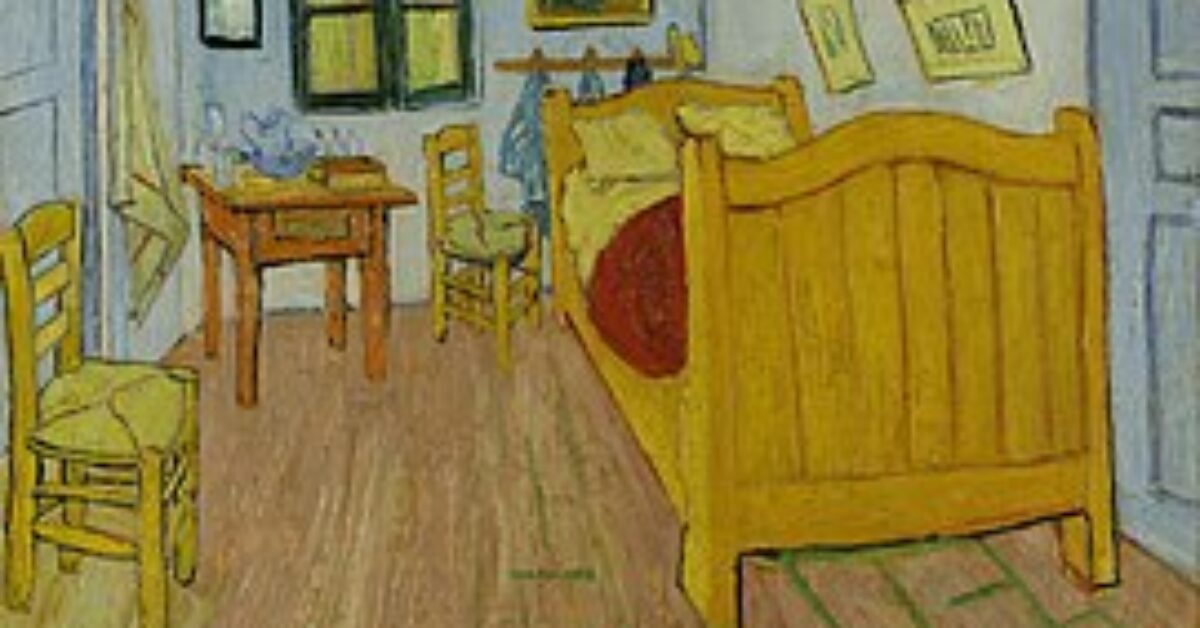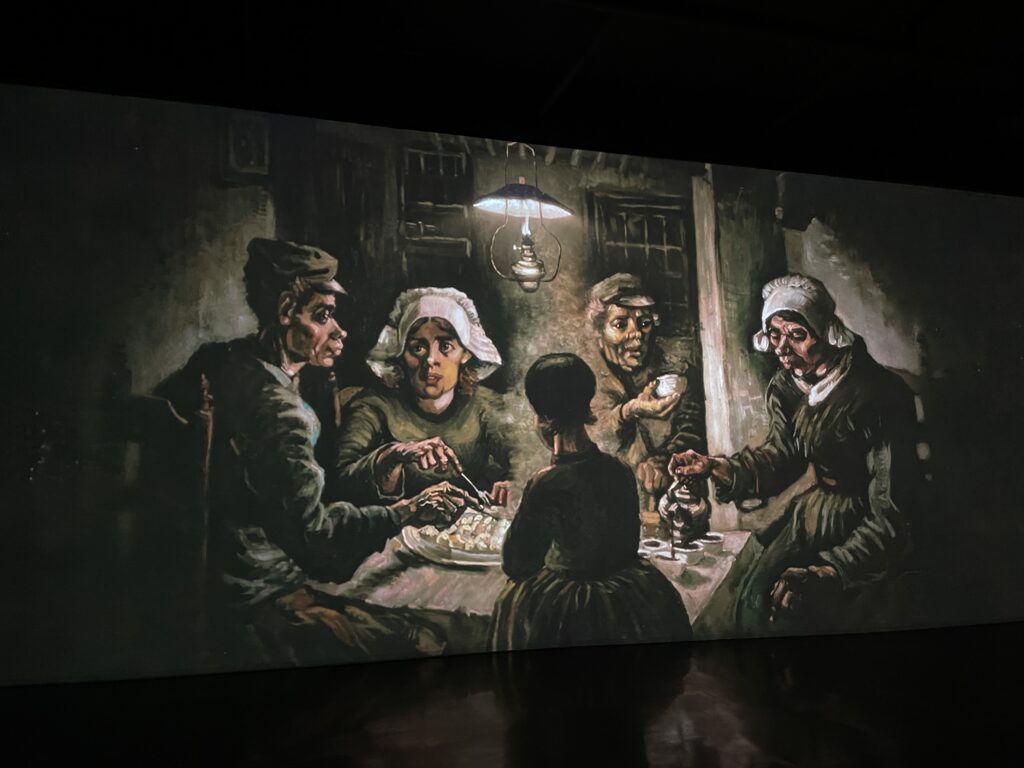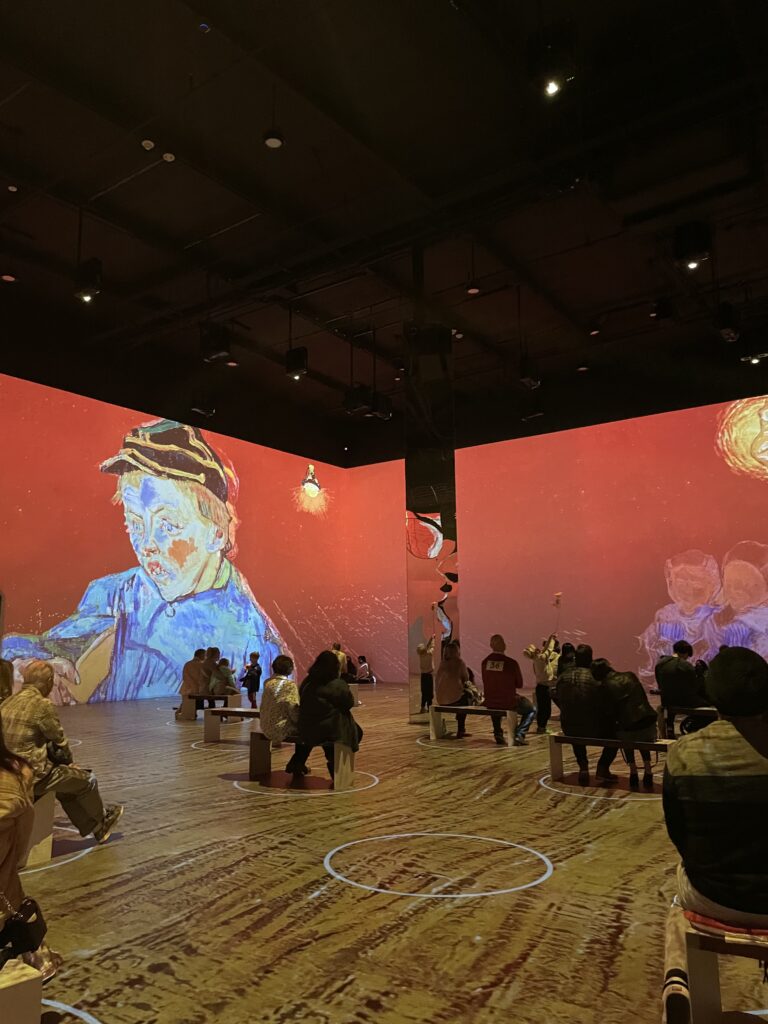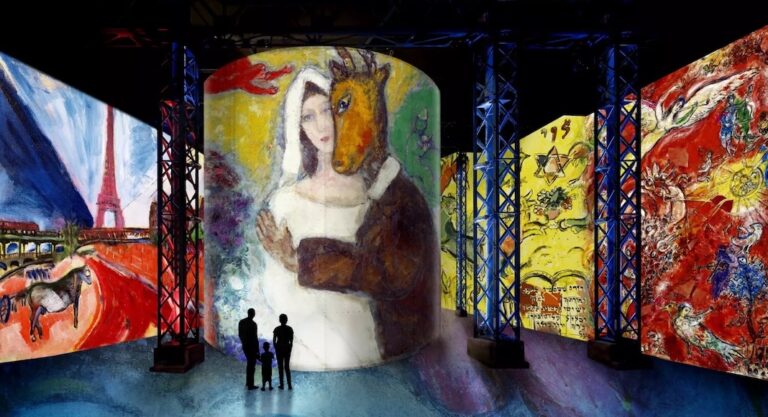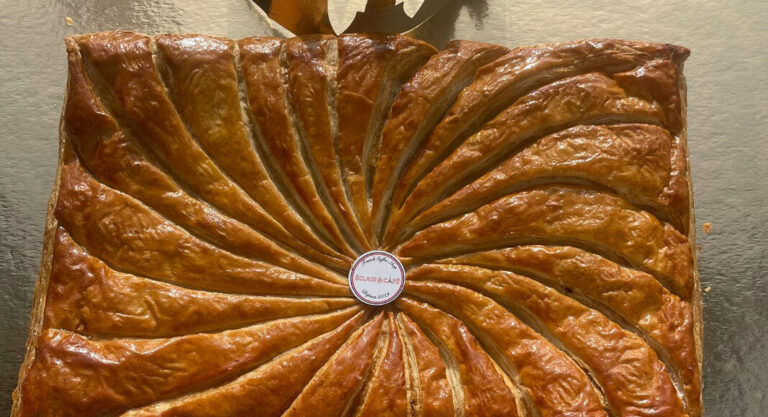From Paris to New York City and on to Berlin, The Immersive Van Gogh exhibits are shaking up how viewers experience art. Recently, I had the pleasure of attending the largest Immersive Van Gogh exhibit in the world, at The Lighthouse Artspace in Los Angeles.
Located at 6400 Sunset Boulevard, in Hollywood, the iconic 55,000 square foot building has been transformed into a wild art experience, featuring a 25,000 foot exhibit space where the art of Vincent Van Gogh comes to life. With wall-to-wall projections of his most famed pieces, you watch the paintings move, spiral and swirl, as exciting contemporary electronic music plays in the background. Created by Massimiliano Siccardi, an innovative artist who started his career studying at The School of Contemporary Dance in London, the music of the show is composed by Luca Longobardi. In 1990, Siccardi left the world of dance and began a new career in video art where he quickly became the artistic dynamo behind visual mise-en-scène for choreographers around the world.
Though I found the exhibit breathtaking, and emotionally gripping, as a bona fide Francophile, I asked myself, “What would this exhibit (or, indeed, the world) have looked and felt like had Vincent Van Gogh never stepped foot in France? Wasn’t Arles, Provence Van Gogh’s muse for some of his most renowned paintings and drawings today? And would there be an Immersive Van Gogh exhibit at all had he never ventured to La France?”
Van Gogh lived and painted in numerous cities throughout Europe, but he spent the last four years of his incredibly short life, (thirty-seven), in Paris and Arles. Born in the Netherlands, the Dutch Post-impressionist artist created thousands of artworks in the small span of ten years, more than most artists paint in a lifetime. However most of his best-known paintings date from the last two years of his life when he lived in France.
Originally, Van Gogh had planned to be a pastor, and worked as a lay preacher in Belgium. It was only when he was fired from this job that he turned to painting. In fact, Van Gogh didn’t start painting until he was 27 years old, and he never received any formal training. But as it was his destiny to paint, so, too, was his destiny to live in France where he would create what are now considered some of his best paintings such as, Café Terrace at Night, and his unsettling, Bedroom in Arles.
In his early career, Van Gogh painted with dark and somber colors that reflected his childhood surroundings. Often capturing stark and dismal landscapes of farmland and the tired faces tilling the soil or gathering crops.
As I watched Van Gogh’s The Potato Eaters flash across the exhibit’s walls, I found myself growing melancholic. The worried, vacant faces gathered around the table pulled at my heartstrings as I reflected on my own life as a multi-disciplined artist and the struggles I’ve faced in pursuit of my passions. In the backdrop, sad, almost-eerie music played, contributing to the heaviness I felt and I had a wistful yearning to better understand Van Gogh’s complexities, as well as my own.
In 1886, Van Gogh moved to Paris and his style drastically changed. Greatly influenced by the French artists he met including, Émile Bernard, Henri de Toulouse-Lautrec, and Paul Signac, he began using brighter, lighter colors to express emotions and he began experimenting with different painting techniques.
When Edith Piaf’s voice belted through the art space singing, “Je Ne Regrette Rien” and paintings such as Windmills on Montmartre, and The Fourteenth of July in Paris ignited the room, I wanted to weep, as a heavy nostalgia surged through me, remembering a time not so long ago that I, too, lived, loved and created in Paris.
Although Van Gogh suffered from mental illness — what would be described as schizophrenia or bi-polar disorder today — in Paris, he seemed to thrive as he was organizing exhibitions, advocating for an artists’ association, and building an art collection of his work with his beloved and ever supportive brother, Theodorus. On the bustling hilltops of Montmartre, where Van Gogh lived, Theo encouraged his brother to paint brighter, and use more color. Van Gogh wrote, “For, Theo, with painting, my real career begins. Don’t you think I am right to consider it so?” Whether it was the support of his brother or his new surroundings, in Paris, Van Gogh’s artistic palate blossomed, and he would go on to create his cherished, Flowers in a Vase.
As les fleurs danced on the walls at Lighthouse Artspace, from billowy yellow sunflowers to brilliant red poppies and roses, I smiled. A lighter mood, a happier moment in time, and an overall sensation of ease flooded through me.
While Van Gogh produced an astonishing amount of work in Paris, after two years, he grew tired of city living and moved to Arles in the South of France. In Arles, he moved into, The Yellow House, which he used as his studio and befriended the artists Eugène Boch, Dodge MacKnight and Christian Mourier-Petersen. He longed to turn the house into a “studio of the south” where artists could live and work together. French artist Paul Gauguin, whom Vincent had befriended in Paris, lived and worked with him in the Yellow House for several months. This period was highly productive for both artists, as Van Gogh made 36 canvases and Gauguin completed 21. Unfortunately, after nine intense months of working together, their divergent ideas about art and their contrasting personalities shattered the relationship.
Relationships aside, while in Arles and in the Yellow House, Van Gogh managed to complete hundreds of sketches and more paintings, over 300 in total, many considered master works of art today–most notably, those of the house itself.
Watching as the Yellow House reflected back at me in the exhibit, I day-dreamed about the time I lived in Aix en Provence. The painting’s vast, open sky and the welcoming shapes and colors of la maison, ignited the same feelings in me that I had while living in Aix en Provence, bewitched and euphoric.
Sadly, for Van Gogh, his time in Arles and the sunflower colored house was cut short as his mental health declined, becoming unmanageable. In 1888, after a quarrel one evening with Gaugin, he grabbed a straight razor and stormed out of the house, intending to harm his friend, but returned home instead. There, he used the weapon on himself, slicing off one ear. Shortly after that horrific event, Van Gogh committed himself to an insane asylum in Saint Remy de Provence.
A tragic life, with a tragic ending, still, Van Gogh’s genius persisted through his mental breakdown. In his asylum room, while looking out of his east facing window, he created what would become his most famous work of art, Starry Night.
Though it is wildly contested how Van Gogh died, most theories suggest he committed suicide, though some surmise he was shot. His brother, Theo, who was at his side when he took his last breath, said that Vincent’s last words were “la tristesse durera toujours,” which means, “the sadness will last forever.”
Feeling as though I had stepped into the Starry Night painting at the immersive exhibit, the effervescent yellows and blues engulfed me as my heart broke, knowing it was one of the last masterpieces he would ever create.
Commercially unsuccessful during his lifetime, having sold only one painting, and considered crazy, Van Gogh’s work has had a lasting impact on the world. Today, his paintings are among the most expensive and revered. Countless poems, books, songs and films have been created to immortalize Van Gogh’s life and art.
As the immersive exhibit came to an end for me, I recalled those last words uttered by Van Gogh. If only he were alive today to see the legacy his art and life have left behind.
And I found myself wondering, would Van Gogh have left the mark he has, had it not been for his time spent in France? Would an immersive Van Gogh exhibit have been created at all?
Kacie Devaney is a professional writer for TV, film and stage. She lived in France on and off for ten years, New York City for five years, and currently resides in Los Angeles. A bonafide Francophile, France and French culture always find a way into her writing. You can learn more about Kacie and her work at her website, here. Photos courtesy of the author.

